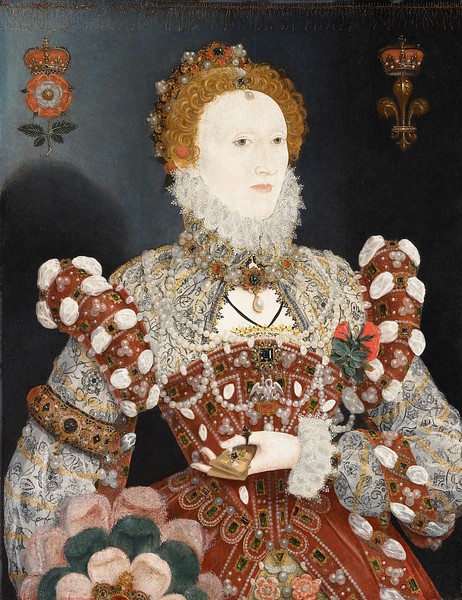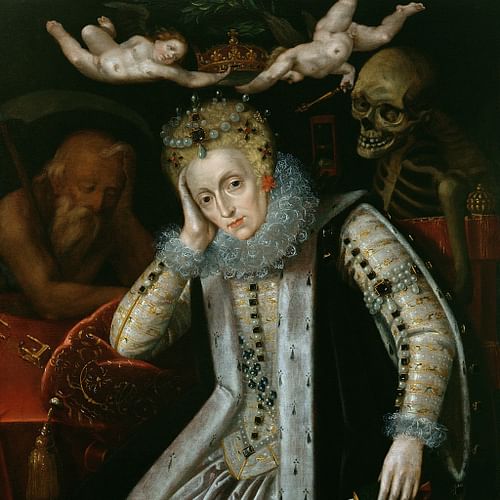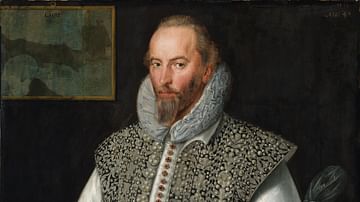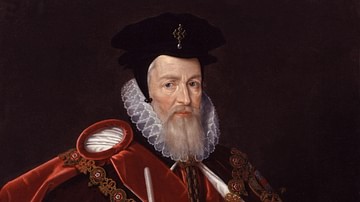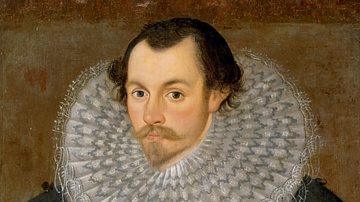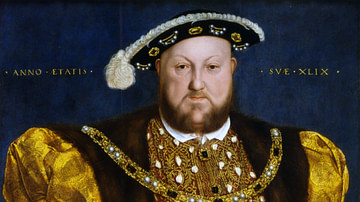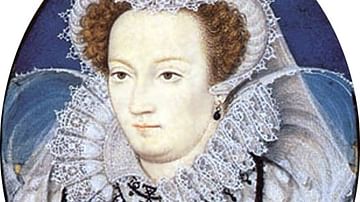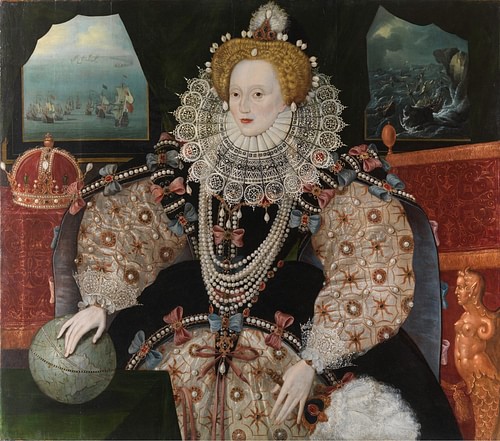
Elizabeth I reigned as queen of England from 1558 to 1603. Her 44-year reign was so long and packed with momentous events that the second half of the 16th century is now known as the Elizabethan era and still regarded as a 'Golden Age' for England.
Elizabeth succeeded her elder half-sister Mary I of England (r. 1553-1558). Exasperating ministers and suitors alike with her prevarication, the queen was a shrewd and capable ruler who survived plots which threatened her life and the 1588 invasion of the Spanish Armada which threatened her kingdom. Glorifying in her own carefully cultivated legend, Elizabeth ruled an England which grew in confidence, witnessed the plays of William Shakespeare (1564-1616), and saw the exploration of the New World. Elizabeth died aged 69 in March 1603, and as the Virgin Queen left no heir, she was succeeded by her closest relative James VI of Scotland (r. 1567-1625) who became James I of England (r. 1603-1625).
Early Life
Elizabeth was born 7 September 1533 at Greenwich Palace, the daughter of Henry VIII of England (r. 1509-1547) and Anne Boleyn (c. 1501-1536). The princess was named after her grandmother, Elizabeth of York (b. 1466), wife of Henry VII of England (r. 1485-1509). When her father fell out with Anne (and had her imprisoned and then executed), his marriage was annulled and Elizabeth was declared illegitimate. The king then married his third wife, Jane Seymour (c. 1509-1537) in May 1536. Jane gave Henry a legitimate son, Edward, who would succeed his father and become Edward VI of England (r. 1547-1553). Elizabeth did not find a happy family home until her father married his sixth and final wife, Catherine Parr (c. 1512-1548) in July 1543. Catherine Parr undertook the welfare and education of her adopted children, which for Elizabeth included learning French, Italian, Latin, and Greek, as well as studying theology, history, music, moral philosophy and rhetoric (which came in handy later for her self-penned speeches as queen). When Catherine remarried after Henry's death, there were allegations against Elizabeth's stepfather, Thomas Seymour (c. 1508-1549), that he had behaved lewdly and improperly with a willing Princess Elizabeth.
During the reign of her brother Edward, Elizabeth kept a low profile and resided at Hatfield in Hertfordshire. When Edward died in July 1553 and left no heir, his eldest half-sister Mary, daughter of Catherine of Aragon (1485-1536) inherited the English throne. Both Henry VIII and Edward VI had pursued the Protestant Reformation of the Church of England but Mary, like her mother, was a staunch Catholic. Mary reversed the reformist legislation that had been passed by Parliament since 1529 and earned her lasting nickname 'Bloody Mary' by burning prominent Protestants at the stake. Mary also departed from Tudor tradition and married Prince Philip (l. 1527-1598), son of King Charles V of Spain (r. 1516-1556). Philip became the King of Spain in 1556 and so Mary its queen.
Spain was England's great enemy, and many in the country were concerned that England's wealth would be used to fund Spanish ambitions abroad. A rising level of popular discontent with Mary's political and religious choices broke out in the form of the Wyatt Rebellion of January 1554. The rebels perhaps even hoped to put Elizabeth on the throne and then have her marry Edward Courtenay, the great-grandson of Edward IV of (r. 1461-1470). The rebellion was quashed, but it demonstrated that, for many, Elizabeth represented the new sense of nationalism that was developing in England. Mary suspected her sister of being involved in the rebellion - even if Elizabeth had made no public statements on either the Reformation or Spanish Marriage - and so she was detained in the Tower on 17 March 1554. Two months later, Elizabeth was moved on to Woodstock in Oxfordshire where she was kept under house arrest. The next year the two sisters reconciled and Elizabeth was allowed her freedom back.
Succession
When Mary died of stomach cancer in November 1558 and left no heir, then her half-sister Elizabeth became queen. Elizabeth, who was just 25, was crowned in one of the most magnificent ceremonies ever held at Westminster Abbey on 15 January 1559. Henry VIII's three children had all inherited the throne in sequence, just as he had wished it in 1544 (if none had any heirs). Elizabeth inherited a fragile kingdom surrounded by enemies. All territory in France had now been lost, the state was almost bankrupt, and politics was still very much a male-dominated arena where a queen was expected to marry as soon as possible. Consequently, Elizabeth had to tread carefully in these first years of her reign, and she surrounded herself with capable advisors.
Government
To advise her in government, Elizabeth chose William Cecil, Lord Burghley (l. 1520-1598) to act as her personal secretary. Sir Francis Walsingham (c. 1530-1590) was another who held the prime post of Secretary of State and whose invaluable network of spies spread across Europe. Robert Dudley (l. c. 1532-1588), who would become the Earl of Leicester, was another favourite. These men would remain at the queen's side for most of her reign although the relationship with Dudley was rumoured to have gone beyond professional bounds. Certainly, it was unusual to give a non-royal an earldom and Dudley had apartments next to the queen's in most of her major residences. Dudley was married, and when his wife was discovered at the bottom of a flight of stairs with a broken neck, many suspected he had pushed her. The ensuing scandal ruled out any prospect of marriage to the queen, but he was, in any case, of too lowly a birth to be acceptable as a queen's consort.
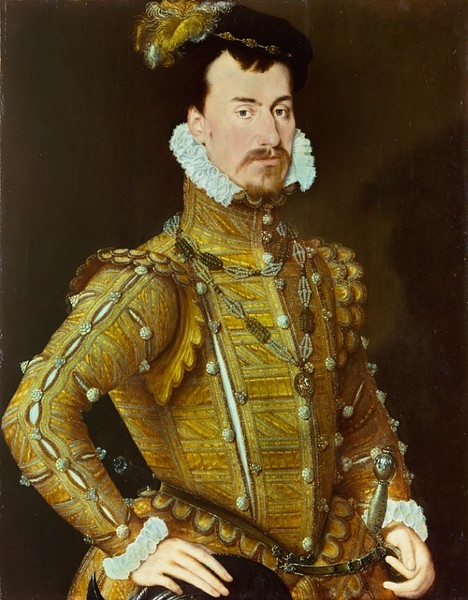
The queen found herself in the man's world of government, but her ministers were about to find out their sovereign had no intention of being pushed around. Elizabeth changed the entire approach to regal policy-making, as the historian J. Morrill explains:
…the dithering, prevarication, and generally dismissive behaviour which was understood to be archetypical of the conventional 'mistress' provided Elizabeth with her weapons of political manipulation and manoeuvre. In order to beat her male courtiers at their own game, she changed the rules and capitalized on the power granted to her by virtue of her gender. (234)
The queen of England was fiercely independent and ministers literally had to woo her to come around to their ideas, if she ever did. The queen had few preconceptions of monarchy. She did not, like so many of her predecessors, hanker after territory in France or Scotland, she was careful over royal spending and seemed not to care at all about securing the Tudor Dynasty after her death. Exasperated ministers could not even turn to Parliament which met only 13 times during her reign.
One of the primary concerns of Elizabeth's advisors was that she should marry and produce an heir or two as quickly as possible. It was taken for granted she should marry, but Elizabeth had other ideas and seemed determined to remain single. Elizabeth was married to her country, so she said, and certainly no monarch had ever toured her kingdom so frequently and shown herself to so many of her people as Elizabeth did.
The queen's reluctance to marry may well have been a reaction to her father's shenanigans with his six wives and Mary's public relations disaster in marrying a Spanish prince. Indeed, Philip II had offered to marry Elizabeth when queen, but he was rejected in January 1559; so too were the king of Sweden, a French prince, and two Habsburg archdukes. Elizabeth thus became known as the Virgin Queen, and for those eager to see divine confirmation of their beliefs, she was the living embodiment of the Virgin Mary. This latter idea became especially prevalent as the queen aged and her imagery increasingly used symbols traditionally associated with the Virgin Mary such as the crescent moon and pearl. There were plenty of informal relations with dashing young men, however, that perhaps went beyond mere friendship. Besides Robert Dudley, 1st Earl of Leicester already mentioned, such figures as the adventurer Sir Walter Raleigh (c. 1552-1618), the Lord Chancellor Sir Christopher Hatton (1540-1591) and the nobleman and cousin of the queen Robert Devereux, the Earl of Essex (1566-1601), all captivated the queen and vice-versa.

Religious Tolerance
Elizabeth returned the Church of England to its reformed state as it had been under Edward VI. She reinstated the Act of Supremacy (April 1559) which put the English monarch at the head of the Church (as opposed to the Pope). Thomas Cranmer's Protestant Book of Common Prayer was reinstated (the 1552 version). Hard-line Protestants and Catholics, though, were both dissatisfied with Elizabeth's pragmatic stance as she went for a more middle-of-the-road approach which appealed to the largely indifferent majority of her subjects. Extremists of the Catholic faith or otherwise were largely permitted to pursue their beliefs without interference, even if the Pope excommunicated the queen for heresy in February 1570. Elizabeth was also active abroad. She attempted to impose Protestantism in Catholic Ireland, but this only resulted in frequent rebellions (1569-73, 1579-83, and 1595-8) which were often materially supported by Spain. The queen also sent money and arms to the Huguenots in France and financial aid to Protestants in the Netherlands.
The thorny issue of the Reformation then twisted its way back into English politics when Mary, Queen of Scots (r. 1542-1567), who was the granddaughter of Margaret Tudor, sister of Henry VIII, became the figurehead for a Catholic-inspired plot to remove Elizabeth from her throne. Indeed, for many Catholics, Elizabeth was illegitimate as they did not recognise her father's divorce from his first wife Catherine of Aragon. Catholic Mary, who had been exiled in France, was not welcomed in Protestant Scotland and, battling husbands and nobles, she was eventually obliged to abdicate in 1567 and then flee the country in 1568.
Mary, Queen of Scots
In 1568, Mary was imprisoned when she arrived in England. Even in confinement, she was a danger to Elizabeth who dithered over what exactly to do with her cousin. The following year there was a rebellion in the north of England stirred up by the earls of Northumberland and Westmorland, both staunch Catholics. Elizabeth responded emphatically by sending an army led by the Earl of Sussex and then hanging 900 of the rebels. Then the conspiratorial Duke of Norfolk, who had plotted with Spain to mount an invasion of England and crown Mary queen (the 1571 Ridolfi plot), was executed in 1572. The English Parliament remained keen to secure Elizabeth's throne; already that body had twice formally asked Elizabeth to marry (1559 and 1563). Now there was an additional threat to the dynasty in the form of Mary. Without an heir, Mary could take over Elizabeth's throne. Accordingly, in 1586, Parliament twice asked the queen to sign Mary's death warrant. Elizabeth finally signed the execution warrant on 1 February 1587 after Walsingham had embroiled the former Scottish queen in a plot against her cousin. Mary had sought to encourage Philip of Spain, who she named her heir, to invade England and so Walsingham was able to gather indisputable evidence of her treacherous intentions.
The Spanish Armada
When Mary, Queen of Scots was executed on 8 February 1587, Philip of Spain had one more reason to attack England. Philip was angry at rebellions in the Netherlands which disrupted trade and Elizabeth's sending of troops to support the Protestants there in 1585. Other bones of contention were England's rejection of Catholicism and the Pope, and the action of privateers, 'sea dogs' like Francis Drake (c. 1540-1596) who plundered Spanish ships laden with gold and silver taken from the New World. Elizabeth even funded some of these dubious exploits herself. Spain had not been entirely innocent either, confiscating English ships in Spanish ports and refusing to allow English merchants access to New World trade. When Drake attacked Cadiz in 1587, Philip prepared for war.
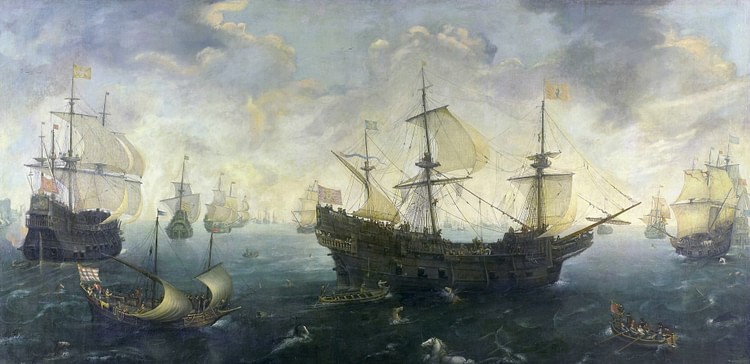
In 1588 the king of Spain assembled a massive fleet, an 'armada' of 132 ships, which sailed from Lisbon to the Netherlands to pick up an army led by the Duke of Parma that would then invade England, the so-called 'Enterprise of England'. Fortunately, Henry VIII and Mary I had invested in the Royal Navy, and this now reaped its reward. The large Spanish galleons - designed for transportation, not warfare - were much less nimble than the fleet of some 130 mostly smaller English ships which were able to dash in and out of the Spanish fleet and cause havoc. In addition, the 20 English royal galleons were better armed than the best of the Spanish ships and their guns could fire further. The English also benefitted from such experienced commanders as Drake whom the Spanish called 'El Draque' ('the Dragon').
There were three separate engagements as the navies battled each other and storms. Meanwhile, Elizabeth visited her land army in person, gathered at Tilbury in order to defend London should the armada make landfall. The queen, wearing armour and riding a grey gelding, roused her troops with the following speech:
I know I have the body of a weak and feeble woman, but I have the heart and stomach of a king, and a king of England too, and think it foul scorn that Parma or Spain or any Prince of Europe, should dare invade the borders of my realm.
(Phillips, 122)


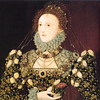
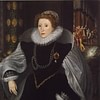


Gallery of Elizabeth I Portraits
Fireships were sent into the Spanish when they anchored their ships, bad weather did the rest. Half of the armada was destroyed, its remnants forced to sail around Scotland. England was saved. 11-15,000 Spaniards had died compared to around 100 Englishmen. Philip did not give up and tried twice more to invade England (1596 and 1597), but each time his fleet was repelled by storms. The defeat of the Spanish Armada gave England great confidence and showed the importance of sea power. The Tudors had built and tested the foundations of the Royal Navy which would go on to change world history from Tahiti to Trafalgar.
Elizabethan Culture
The arts, as so often when peace is established, positively boomed in the Elizabethan age. In 1576 London received its first playhouse, founded by James Burbage and simply known as The Theatre. Around 1593 William Shakespeare wrote his play Romeo and Juliet. The great bard's historical plays such as Richard III were aimed at massaging the Tudor royal ego and so painted a darker picture of pre-Tudor times than was the reality. Meanwhile, plays like Henry V glorified England's past and contributed to an ever-growing sense of nationalism. The queen enjoyed watching plays and outdoor spectacles and actively patronised artists and playwrights. Other notable writers of the period include Christopher Marlowe (1564-1593) and Ben Jonson (1572-1637).
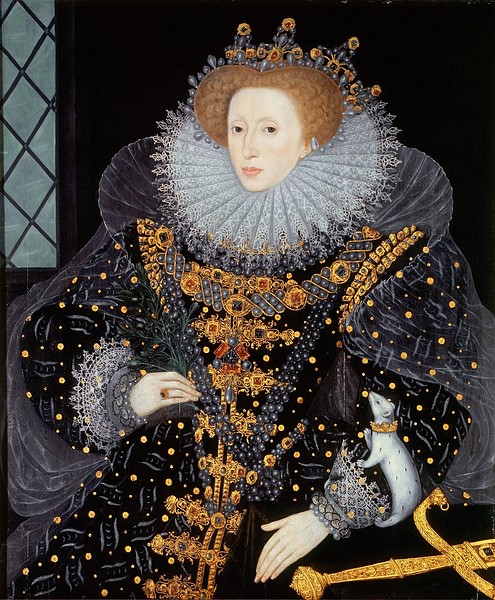
One final cultural phenomenon of the period was the veneration of the queen herself as a semi-divine figure. Elizabeth's date of succession, 17 November, was declared a national holiday and was celebrated each year with great festivities, church services and bell-ringing. Elizabeth became known as the great empress 'Gloriana', after the central figure of the 1590 poem The Fairie Queen by Edmund Spenser (c. 1552-1599). Comparisons were made with Artemis/Diana, the virgin huntress goddess of antiquity. One court spectacle in 1581 depicted the queen as the 'Fortress of Perfect Beauty' successfully withstanding a siege by a cannon representing 'Desire' but which could only fire sweets at its target. Walter Raleigh named a portion of North America (Roanoke Island, modern North Carolina), England's first overseas colony after his queen: Virginia.
An important element in the growing legend that the queen herself cultivated was her appearance. Elizabeth spent two hours squeezing into majestic dresses with extravagant collars and jewelled embellishments. She also wore a striking array of wigs, unfortunately, necessitated by an attack of smallpox in December 1562 which had left her with bald patches. The disease had also left Elizabeth with facial scars, which explains her use of thick white makeup. The queen knew full well the value of imagery, and so from 1563 the production of unofficial portraits was banned. Elizabeth's success at managing her own image is perhaps best illustrated in the fact that the cult of her persona has never really gone away despite the best attempts of revisionist historians.
Death & Successor
It is true that the reality of the final years of Elizabeth's reign was rather less romantic than her legendary image. A run of poor harvests, inflation, and high taxes, needed to pay to fight Spain, and an increase in unemployment and petty crimes, all took their toll on a population which had increased from 3 million at the start of Elizabeth's reign to 4 million by the end of it. Poverty was growing at such a rate that Poor Laws were passed in 1597 and 1601 to try and alleviate the problem by providing houses of correction for vagrants and apprenticeships for children. There were food riots in London and East Anglia in the 1595-7 but, significantly, none of the popular uprisings which had challenged previous Tudor monarchs.
Elizabeth died, likely from a mix of bronchitis and pneumonia, on 24 March 1603 at Richmond Palace. She was 69 years old and had outlived all her friends and favourites; she was buried in Westminster Abbey. As the queen had once said to Parliament, and through that body, spoken to her people:
And though you have had, and may have, many mightier and wiser princes…yet you never had, nor shall have, any that will love you better.
(Cavendish, 299)
The Queen of England's reign may have been assessed less favourably in recent times, particularly its final years, but she still compares well to her immediate predecessors and successors. The queen's greatest failing was perhaps having no children and never nominating an heir. Consequently, she was succeeded by her closest relative, James I of England (aka James VI of Scotland), the son of Mary, Queen of Scots. James would reign until 1625 and so be the first Stuart to rule England. The Stuarts would survive the brief republic of Oliver Cromwell, 1649-1660, and so they remained in power until 1714.
